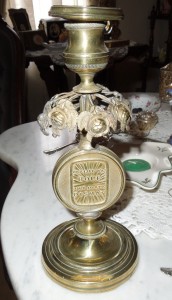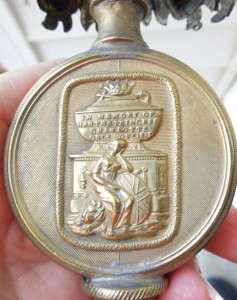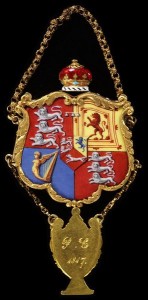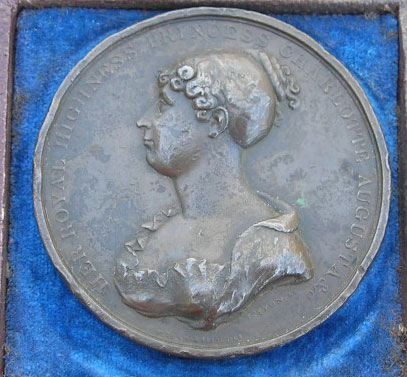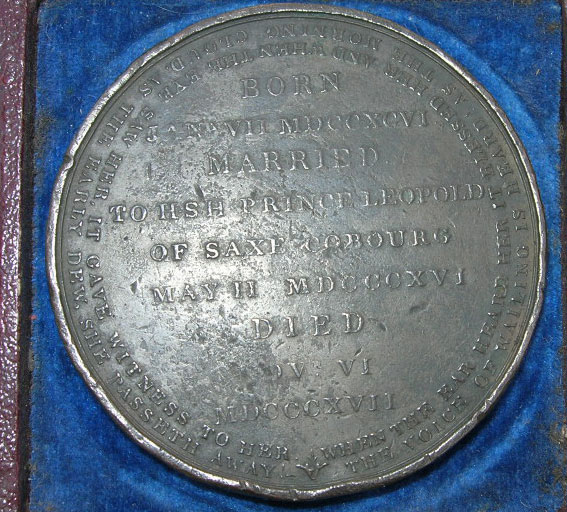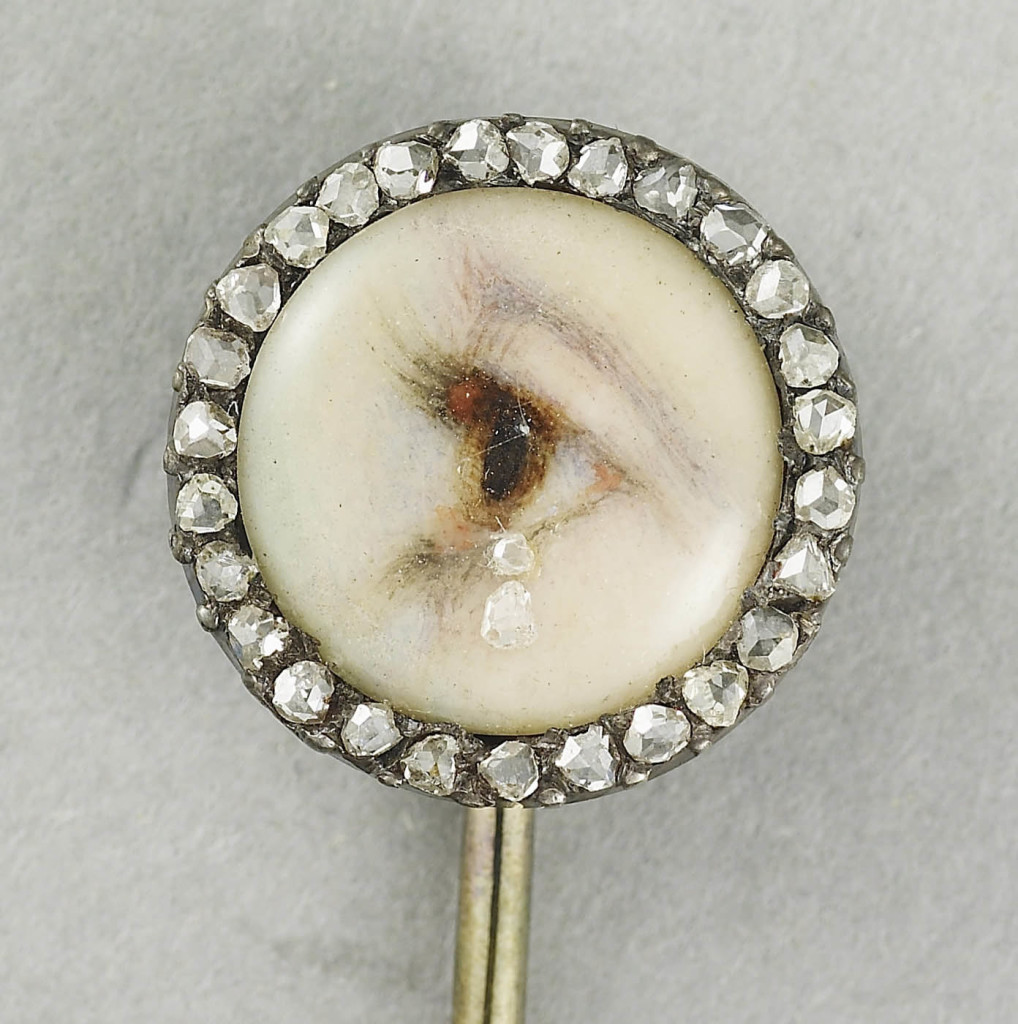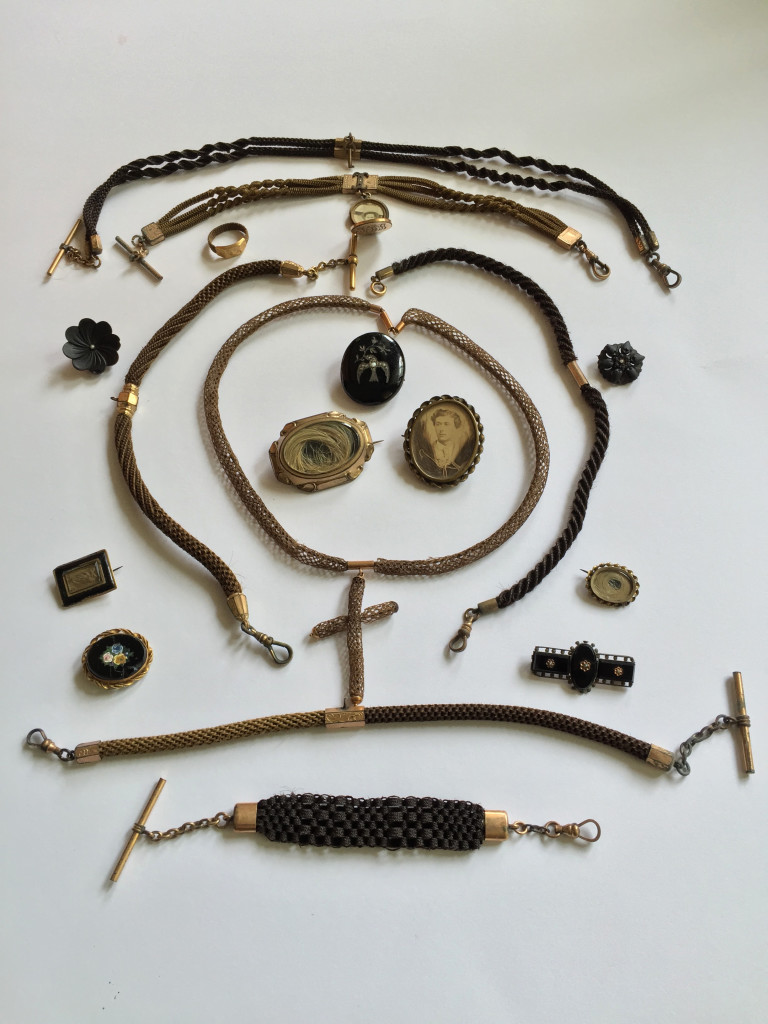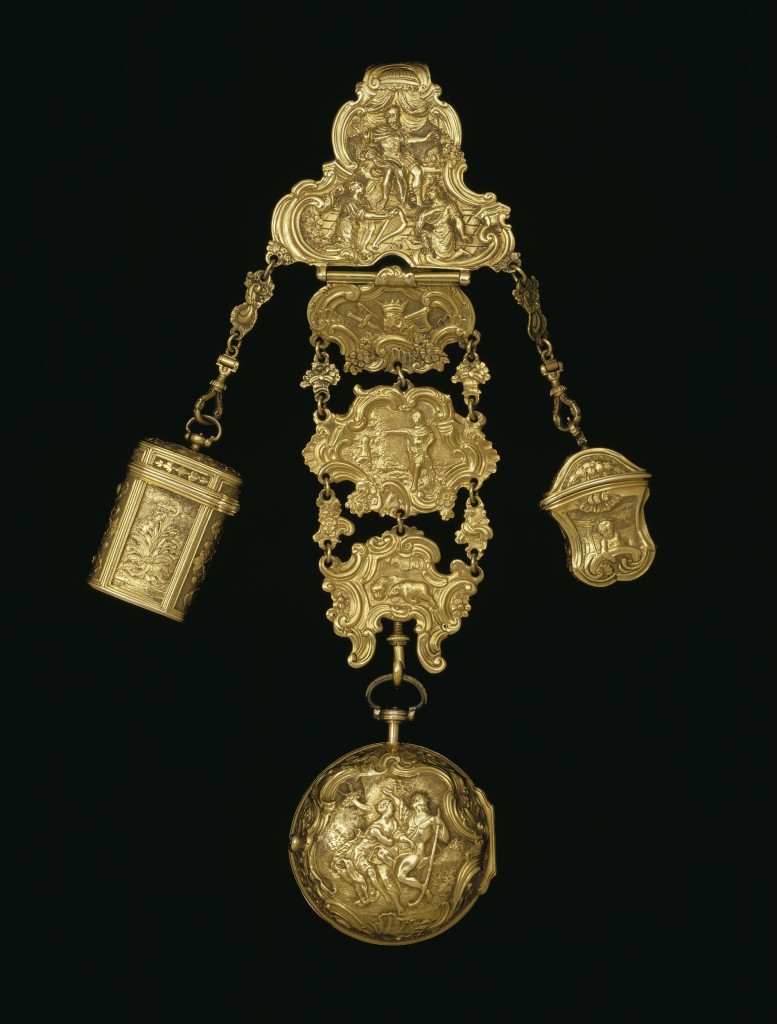Memorial Princess Charlotte Candlestick
The cultural impact of Princess Charlotte of Wales’ death is one of the most significant events in Western cultural mourning during the 19th century. Future events, such as the death of Prince Albert in 1861 and its impact on Queen Victoria resonated through a society which had the establishment of mourning culture engrained in its systems. These elements of mourning that were considered proprietary in the mid 19th century had their roots in the death of Princess Charlotte, as this remarkable candlestick show.
Princess Charlotte of Wales
Born Charlotte Augusta on the 7th of January, 1796, Charlotte was next in line to become Queen of the United Kingdom. Her father, George IV, had a contentious relationship with her as she grew older, with pressure to marry William, Hereditary Prince of Orange, a courtship that she ended. Eventually, she married Prince Leopold of Saxe-Coburg-Saalfeld, a relationship that lasted one and a half years.
Charlotte’s mother, Caroline of Brunswick, had restricted access to her after her birth, allowed only by the accompaniment of a nurse and governess. In 1794, Caroline and the Prince of Wales were engaged, but hadn’t met, George had pursued this marriage due to debt. Her critics, with their leaning towards the throne, were not kind to her appearance or behaviour, however she was equally critical of George, stating that George was ‘very fat and he’s nothing like as handsome as his portrait.’ She was also critical of his excesses. George’s true love, Maria Fitzherbert, can be read about in the following article about miniature eye portraits:
Charlotte’s upbringing was praised by King George III who considered that her birth would bring Caroline and George back together, but the Prince of Wales was not so thrilled by the prospect of a daughter, rather than a son. George left a will stating that Caroline have no role in Charlotte’s upbringing and left her only one shilling.
Charlotte was christened Charlotte Augusta on the 11th of February, 1796, and became popular in the public’s eye. Breaking restrictions, her mother, Caroline, would be allowed by Charlotte’s careers to visit and even ride through London in a carriage, seen by the populace. Conflict between the Prince and Caroline continued through Charlotte’s childhood, however she remained close to George III. Upon George III’s affliction of ‘madness’, her father was sworn in before the Privy Council as the Prince Regent on February 6th, 1811. Political views, surrounding the Whigs, caused conflict in their relationship, placing restrictions from George upon her; both monetarily and socially. By 1813, George tired to enforce the wedding between Charlotte and William, the Hereditary Prince of Orange, a wedding frowned upon by the Princess of Wales and the public. George tired to involve her with even heavier restrictions, calling her to Cranbourne Lodge without being permitted to be seen by another other than the Queen, driving Charlotte to her mother and supporters. She was advised to follow her father’s orders and remained at Cranbourne Lodge until movement to Weymouth. By 1815, she had turned her affections to Prince Leopold of Saxe-Coburg. Following her father’s approval, an announcement was made in the 14th of March, 1816 to the House of Commons about their impending marriage. The two were married on the 2nd of May, 1816, to the great acclaim of the populace of London at 9pm.
Suffering a miscarriage in 1816, Charlotte remained in the social spotlight, yet under watch by the physician-in-ordinary, with another pregnancy announced in April 1817. On the 5th of November, 1817, Charlotte gave birth to a stillborn child and died soon after.
Charlotte’s Death
The death of Queen Charlotte was one of high cultural impact upon the United Kingdom, following on from her popular perception in the public eye. This cascading effect led to the production of memorial tokens of affection that were created to symbolise her loss.
In the same way that the culture created tokens for Horatio Nelson, Wellington and Napoleon, this was a society that had the means to create popular souvenir tokens for the event, the craftspeople to deliver them in high demand and increased production through discoveries in the Industrial Revolution.
However, regardless of the affectation, this was still a society in shock, Charlotte’s death fed an industry that demanded the tokens of mourning to show their love and appreciation for her and her child.
Cultural Impact
One of the most important reactions to Charlotte’s death, from a mourning perspective, were to the stage of mourning and the requirement of fashion. These requirements resonated throughout the 19th century and led to the height of the mourning industry. This was a culture with a high mortality rate and a culture that looked to the crown for the requirements of proprietary surrounding love and death. A culture that needed to follow the context of ordained indoctrination in the affectations of fashion which established the following stages of mourning.
Mourning regulation went through different permeations in the 19th century and became longer and more rigid. It was on the 7th of November, 1817 upon the death of Princess Charlotte that Lord Chamberlain ordered official Court mourning: ‘the Ladies to wear black bombazines, plain muslins or long lawn crape hoods, shammy shoes and gloves and crape fans. The Gentlemen to wear black cloth without buttons on the sleeves or pockets, plain muslin or long lawn cravats and weepers [white cuffs] shammy shoes and gloves, crape hatbands and black swords and buckles.’ For undress wear, dark grey frock coats were permissible. The Second stage was decreed two months later, with the allowance of black silk fabric, fringed or plain linen, white gloves, black shoes, fans and tippets, white necklaces and earrings, grey or white lusterings, damasks or tabbies and lightweight silks for undress wear. Men’s dress was unchanged. The third stage allowed women to wear black silk and velvet, coloured buttons, fans and tippets and plain white, silver or gold combination coloured stuff with black ribbons. Men could wear white, gold or silver brocaded waistcoats with black suits. The rules set by Lord Chamberlain crossed Europe, the United States (from the 1860s / 70s) and colonial territories, but Court mourning was longer than General mourning. General mourning was growing in popularity due to the accessibility of mourning costume and the cost.
Everything from tea services, prints, poems and tea services were created for Charlotte, even with a petition to St George’s Chapel erecting a large marble structure for her. This ranged from levels of society, with Lord Holland noted that there were “signs of mourning on their persons” to the postboys and turnpike men that he passed.
Memorial Accessories
Many souvenirs of Charlotte’s death were available at the time, using her image or imprinted with a memorial of her birth and death dates. This candlestick shows the level of ancillary accessories that could be used around the house to show the owner’s statement of mourning for the Princess. This impact upon the lives of people, regardless of their cultural status, led to the higher creation of memorial items in various levels of quality. From the above imposition of mourning through Lord Chamberlain, society needed to mourn and Charlotte’s death only led to higher industry. Household items, such as this candlestick, were popular, even jewels of the time. The following piece from the Victoria and Albert Museum shows the height of Charlotte’s memorial pieces:
“This memorial pendant was made in 1817 to commemorate the death of Princess Charlotte. She was the only daughter of the Prince of Wales (the future George IV) and his wife, Caroline of Brunswick. Charlotte had married Leopold of Saxe-Coburg, the future king of the Belgians, in 1816 and died in childbirth the following year. Three locks of her hair have been curled into the shape of Prince of Wales’ feathers. These are mounted in the vase that hangs below the miniature. Charlotte’s coat of arms is enamelled on the reverse.
Charlotte Jones was appointed miniature painter to the Princess, and exhibited portraits of her at the Royal Academy in 1808, 1812, 1816 and 1819. This miniature may have been exhibited in 1816. Jones painted a portrait of the same composition in 1814, and the engraver John Samuel Agar published a stipple engraving after this portrait in the same year.”
This remarkable candlestick shows many elements of the Neoclassical movement in its design, but brings them into a three-dimensional object. Where a jewellery collector is used to seeing many of these symbols in-situ, painted upon ivory or vellum on a ring or pendant, this piece creates volume, with the withering roses and the grand statement upon its mid-section. The grand statement of:
“Her life was hope / Her death dismay”
Shows the level of grief that her death had on the population. Hope, meaning that the continuity of the crown through Charlotte’s establishment as subsequent Queen after the death of her father, gives the United Kingdom hope. This is a ruler who would have led society into a new value system and one that had already be seen to react against her father.
Dismay is a revelation upon her father’s rule and its perception, as well as the future of the kingdom. A population that felt so positive towards Charlotte is pronounced in their grief and uncertainty for the future. When linked with the reign of Queen Victoria and her impact upon cultural values, we start to see a narrative of reaction against the excesses of George IV in society, a reaction that Charlotte could have led. Upon the reverse, we see the weeping Britannia, a figure normally held for the female mourner, weeping before the urn and plinth; with her, the entire kingdom weeps.
However, cameos and memorials, such as the below coin, were predominantly available to the public as souvenirs that were attainable.
The following inscription upon the coin reads:
“Born Jan VII MDCCXCVII Married to H.R.H. Prince Leopold of Saxe Cobourg May 11 MDCCCXVI Died Nov VI MDCCCXVII
When the Ear Heard Her It Blessed Her And When The Eye Saw Her It Gave Witness to Her The Voice of Wailing is Heard: As the Morning Cloud, As The Early Dew, S”
The level of grief and outpouring of emotion to create these pieces goes beyond the requirements of Court. This shows the society of the time and their affections towards Charlotte in items that were desirable for their sentimental purposes, beyond their affectation of beauty or social reverence. The resonation of this affection would be felt throughout the mourning jewels produced after 1817, leading into the Gothic Revival period and the return to a value system which moved away from the excesses of George IV.




